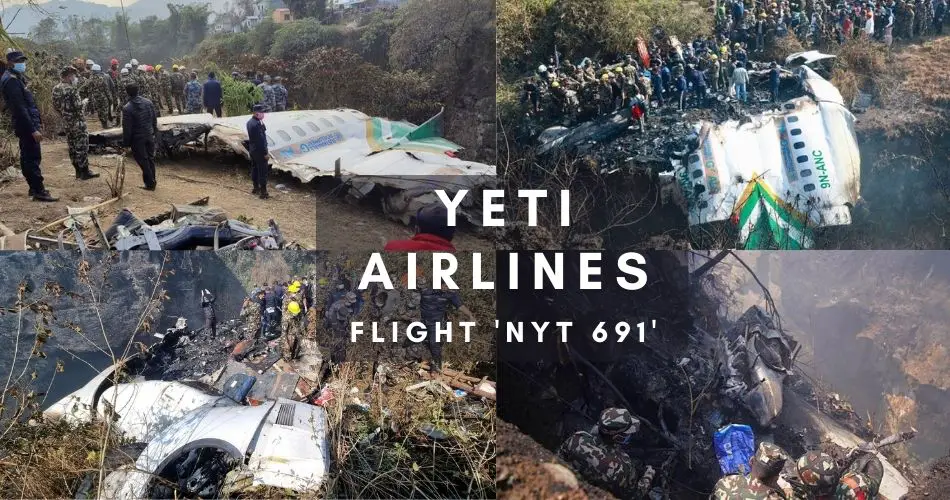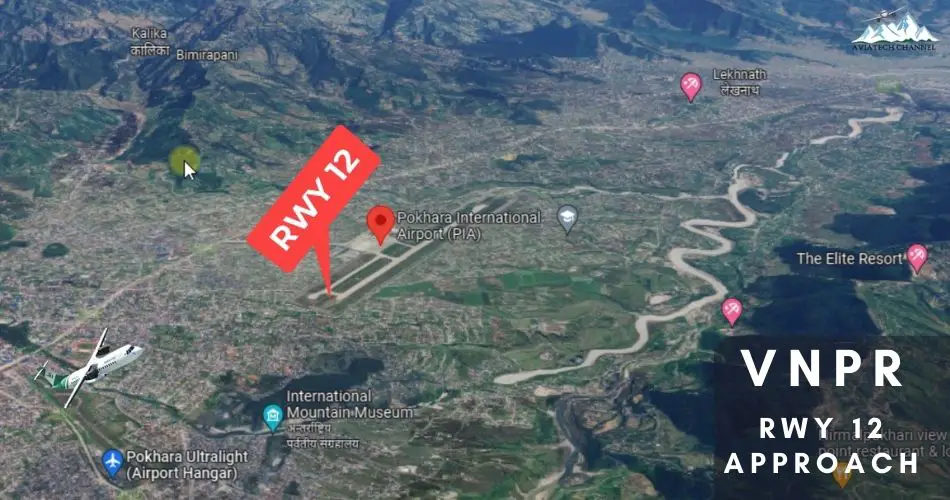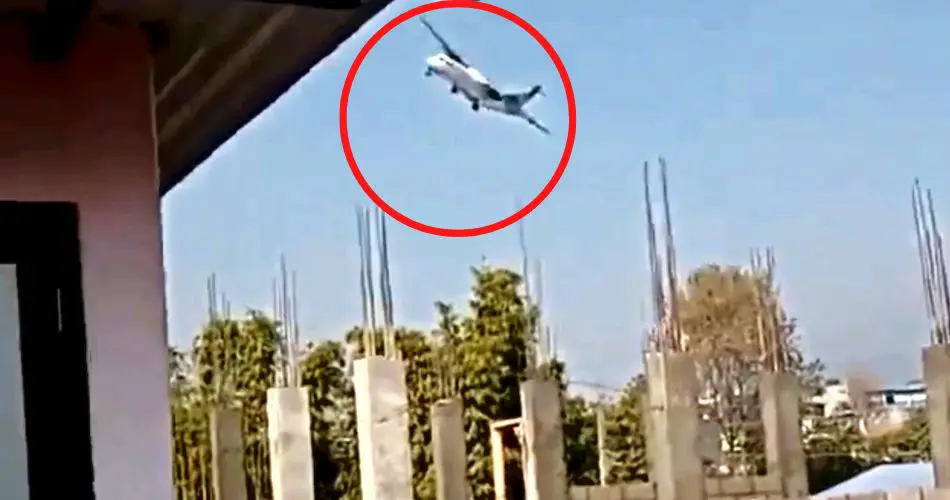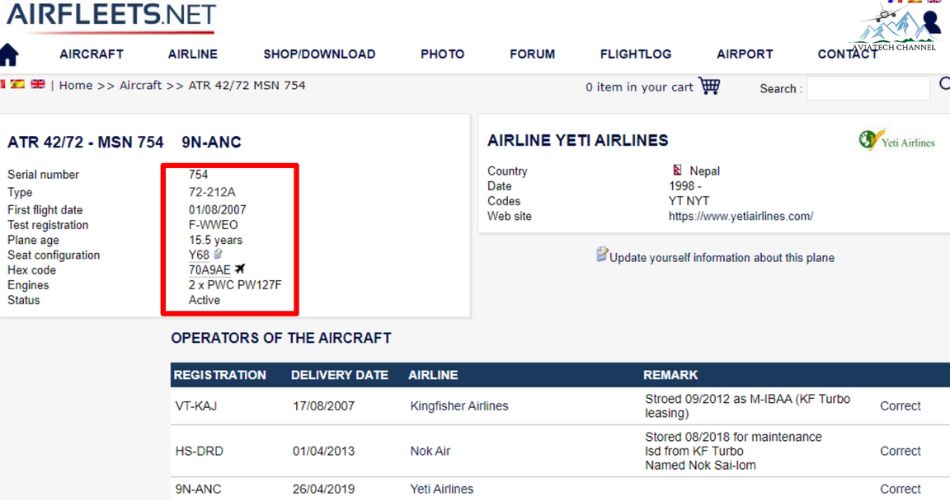Yeti Airlines Flight 691 – Another black day for Nepali Aviation
On 15th January 2023, an ATR 72 with registration ‘9N-ANC’ belonging to Yeti Airlines, one of the leading domestic carriers of Nepal, crashed on its way to the newly constructed Pokhara International Airport (VNPR) from Kathmandu’s Tribhuvan International Airport (VNKT).
There were a total of 72 occupants on the flight ‘NYT 691’ that could not make its final approach to the new international airport in Pokhara, the tourist city. 72 occupants in the ATR 72 included 68 passengers from different countries and 4 flight crew members.
Passenger numbers with respective countries
| COUNTRY | NUMBER OF PASSENGERS |
| Nepal | 53 |
| India | 5 |
| Russia | 4 |
| South Korea | 2 |
| Ireland | 1 |
| Australia | 1 |
| Argentina | 1 |
| France | 1 |
| TOTAL | 68 passengers |
AviaTech Channel expresses its deepest sympathy and unwavering support to the bereaved families. May all the departed souls rest in peace.
The aircraft crashed in the deep gorge of the Seti River near Pokhara Domestic Airport. At the time of writing this article, the rescue team has been able to collect the dead body of 71 occupants, and the search is going on for the remaining one body.

History of the fatal crash (Yeti Airlines Flight 691)
Yeti Airlines ATR 72 ‘9N-ANC’ departed from Tribhuvan International Airport (VNKT) in the capital city outbound to Pokhara International Airport (VNPR) approximately at 10:32 am local time. This flight was operated under the command of experienced instructor pilot Captain Kamal KC and co-piloted by Captain Anju Khatiwada.
Flight 691 was scheduled to land at the new Pokhara International Airport as it was inaugurated by Prime Minister Pushpa Kamal Dahal on 1 January 2023 replacing the old domestic airport. VNPR is equipped with an 8,200 ft (2,500 m) long runway, and its designation is 12/30.

The flights arriving from Kathmandu normally use Runway 30 as it is a direct approach path, and can be navigated easily by following the Lekhnath city. However, Yeti’s flight 691 requested VNPR ATC to land at Runway 12 which is near the domestic airport. For this approach, the aircraft needs to fly aside from the international airport and make a significant turn to align with Runway 12.

Yeti’s crew flew their aircraft to the right side of the new international airport, and initiated a left turn near the Pokhara domestic airport to align with Runway 12. When making a left turn, the aircraft’s bank angle tilted heavily to the left side making the wings nearly vertical before stalling, and crashing at the Seti Gorge.

One of the local residents was able to capture the video of Yeti’s ATR 72 making a sharp left bank, and crashing at the deep Seti Gorge with a loud bursting sound. Immediately after the impact, the aircraft caught huge fire, and local residents rushed to the crash site.
The rescue team including Nepali Army, Nepal Police, Airport Fire Fighting Team, local authorities, and other respective bodies immediately reached the site for the necessary rescue, and evacuation process.
Unfortunately, there were no survivors!!! This is probably the biggest crash in the domestic aviation industry of Nepal.
What could be the reasons behind this fatal crash?
The overall weather in Pokhara city was clear. The visibility and wind speed were completely normal for safe flight operation. The flight crews were highly diligent with enormous flying experience. There were no technical glitches reported to the ATC.
With all these normal conditions, the aircraft crashed leaving a tough task for investigation experts. As claimed by the witnesses, the ATR 72 was approaching in an unusual behavior before crashing. The majority of local residents reported the aircraft lost its control.

Aviation Experts and Critics are questioning why flight NYT 691 chose Runway 12 instead of making a direct safe approach to Runway 30. There might be various reasons behind doing so. The pilots could be testing Runway 12, there might be traffic on the runway, or some other reasons which will be disclosed with the ongoing investigation.
It is also reported the co-pilot Capt. Anju Khatiwada was seated in the captain’s seat while IP Capt. Kamal KC was on the co-pilot seat on the right side of the cockpit. Capt. Anju was on her final flight to be promoted to the Pilot-in-Command (PIC) so, critics are claiming this could be one of the reasons for the crash. However, all these speculations are hypothetical, and may not match the nature of the crash.
There are chances of sudden technical glitches also. That’s why we need to wait for the complete investigation report.
Besides, people are also skeptical about the age of the aircraft claiming it to be one of the major reasons for the crash. Whenever an air crash happens in Nepal, people always argue the airlines in Nepal purchase old aircraft, and risk the lives of innocent passengers.
Talking about the age of Yeti’s ATR 72 ‘9N-ANC’, it was 15.5 years as it flew for the first time on 1st August 2007. It was then purchased by Kingfisher Airlines (India) on 17th August 2007. Likewise, a Thailand-based carrier Nok Air acquired the same aircraft on 1st April 2013. Later on 26th April 2019, it was purchased by Yeti Airlines.

Aircraft’s age could only be a safety issue if it exceeds the maximum pressurization cycles/flight hours, or the fuselage gets weaker. If you are curious to know the risk of aging aircraft, you can read our detailed blog ‘How many years can an airplane fly?’, and also watch the following video.
Perspective from an ATR Expert Pilot
One of the proficient ATR Pilots Senior Captain Kumar Pandey gave his analysis based on the preliminary information available.
Capt. Pandey holds huge experience (22+ years) in flying ATR aircraft in India and Nepal. He flew as a captain for Necon Air (a defunct domestic airline of Nepal) for almost 9 years. Plus, he has landed more than 1,000 times at Pokhara Domestic Airport. While working for Kingfisher Airlines in India, he flew the same aircraft (that crashed in Pokhara) with registration ‘VT-KAJ’ (‘9N-ANC’ when acquired by Yeti Airlines) logging 100+ hours.

He says the ATR is the most pilot-friendly aircraft, and there are fewer chances of technical failure for Yeti Airlines Flight 691 crash. When asked about the cockpit seating position, he said the co-pilot Anju was a Captain, and she was on her check ride to be promoted to the PIC position. So, it was nothing wrong in this case.
Answering the argument on the age of the aircraft, he made clear the aircraft doesn’t get old quickly if proper/scheduled maintenance, parts replacement, and other engineering tasks are done accurately. Each and every part of an aircraft has its life, even a small nut bolt has its expiry date, he added.
Likewise, addressing the runway approach criticism, Capt. Pandey claimed it is completely normal to land at any of the available runways. This is done to examine the proficiency of the pilot, route check, and other various reasons as per standard procedures. However, the instructor pilot must be alert to make the right decisions in case of any error from the pilot who has control.
There are various warning systems on today’s advanced aircraft. For example, if the ATR 72 exceeds the normal banking angle, it alerts the flight crews with a ‘Bank Angle, Bank Angle’ voice command. The airflow of Yeti’s ‘9N-ANC’ was disturbed when the pilots made a sharp left turn to align with VNPR Runway 12.
The bank angle exceeded the normal threshold, and the left-wing couldn’t sustain the aircraft’s weight putting pressure on the right wing. With that, the aircraft stalled in a fraction of a second, and it’s 100% true. There was no room for the instructor pilot to recover the stall, he added.
Capt. Pandey states all these analyses made are hypothetical, and it is too early to speak on the cause of the crash. The aircraft’s Black Box has been recovered, and the Cockpit Voice Recorder (CVR) & Flight Data Recorder (FDR) report will yield valuable clues for investigation. We need to wait for the outcomes of the investigation!
Conclusion on the Yeti Airlines Flight 691
The fatal crash on 15th January that took the life of 72 occupants is the biggest domestic turbojet crash in Nepal just after 7 months after the Tara Air Twin Otter crash in Manang. Such accidents have been frequently questioning the safety of Nepali aviation.
The European Union (EU) is continually banning all airlines in Nepal citing poor safety records. The country was making some improvements to get lifted with the ban however, frequent crashes have been lengthening the process.
The investigation committee has already been formed, and the necessary investigation process has begun for Yeti Airlines Flight 691. Until, and unless the final report is published, it is not a good idea to execute a blame game.
For now, the aviation regulatory body, as well as the airlines, must adhere to standard safety practices so that there will be fewer chances for major accidents.





